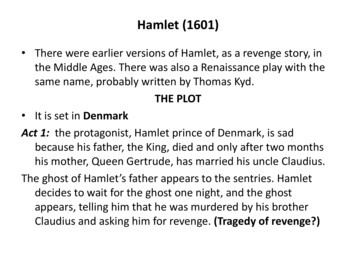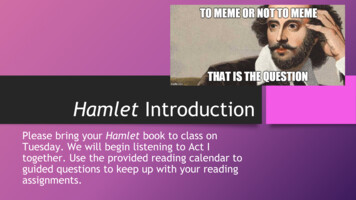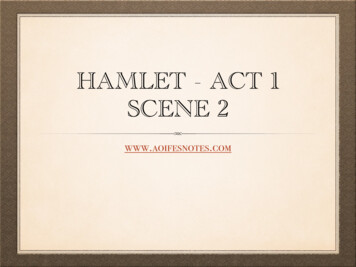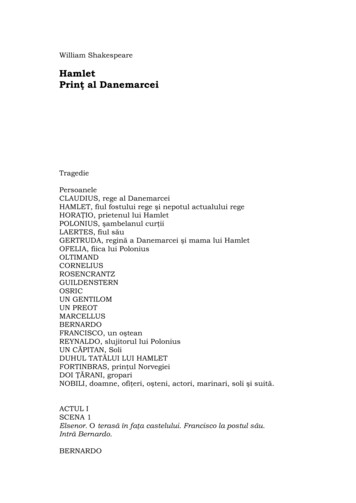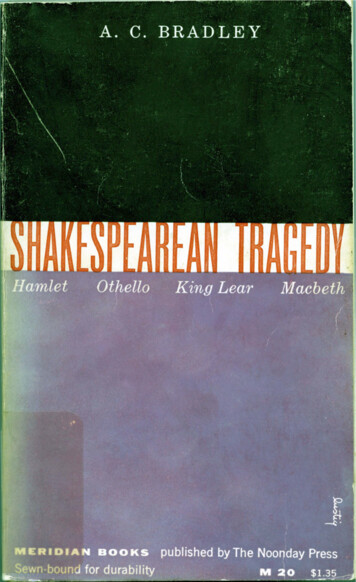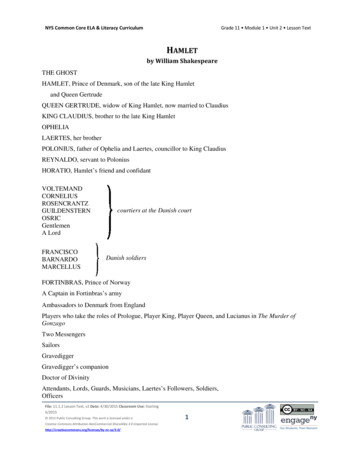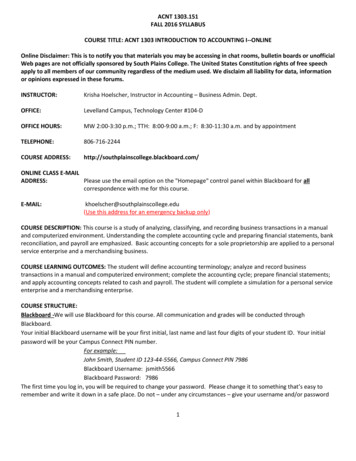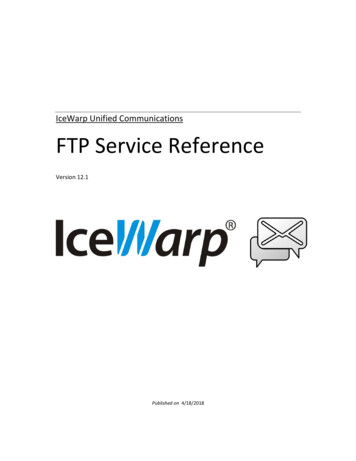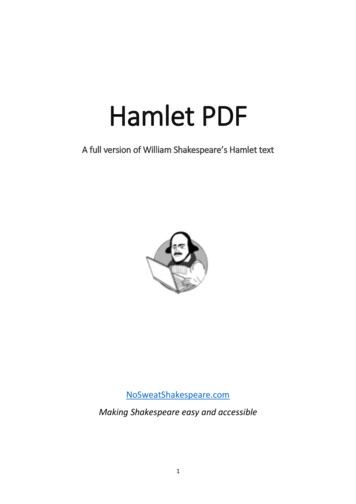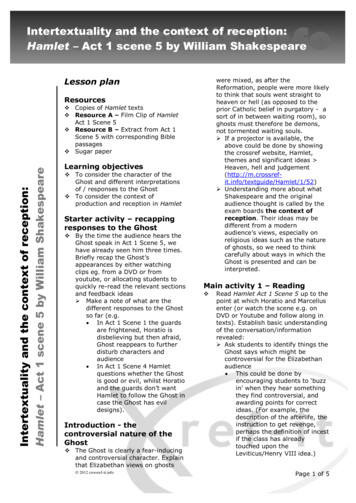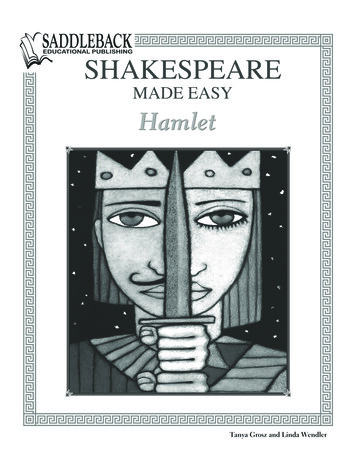
Transcription
Three WatsonIrvine, CA 92618-2767Web site: www.sdlback.comISBN-13: 978-1-59905-130-7ISBN-10: 1-59905-130-3eBook: 978-1-60291-420-9Copyright 2006 by Saddleback Educational Publishing. All rights reserved. No part of this book may be reproduced in any form or byany means, electronic or mechanical, including photocopying, recording, or by any information storage and retrieval system, without thewritten permission of the publisher, with the exception below.Pages labeled with the statement Saddleback Educational Publishing 2006 are intended for reproduction. Saddleback EducationalPublishing grants to individual purchasers of this book the right to make sufficient copies of reproducible pages for use by all students ofa single teacher. This permission is limited to a single teacher and does not apply to entire schools or school systems.Printed in the United States of America10 09 08 07 9 8 7 6 5 4 3 2
ContentsTo the Teacher . . . . . . . . . . . . . . . . . . . . . . . . . . . . . . . . . . . . . . . . . . . . . . . . . . . . . . . . . . . . vIntroduction to the Play . . . . . . . . . . . . . . . . . . . . . . . . . . . . . . . . . . . . . . . . . . . . . . . . . . . viIntroduction to Shakespeare . . . . . . . . . . . . . . . . . . . . . . . . . . . . . . . . . . . . . . . . . . . xvActivity 1: A Father’s Explanation (Act one, Scene 1) . . . . . . . . . . . . . . . . . . . . . . . . . . . . . 1Activity 2: What Ghosts Do (Act one, Scene 1) . . . . . . . . . . . . . . . . . . . . . . . . . . . . . . . . . 2Activity 3: A King’s Explanation and a Son’s Sorrow (Act one, Scene 2) . . . . . . . . . . . . . . 3Activity 4: Brotherly Advice (Act one, Scene 3) . . . . . . . . . . . . . . . . . . . . . . . . . . . . . . . . . 4Activity 5: Review . . . . . . . . . . . . . . . . . . . . . . . . . . . . . . . . . . . . . . . . . . . . . . . . . . . . . . . . . 5Activity 6: Profile of the Prince (Act one, Scenes 2–4) . . . . . . . . . . . . . . . . . . . . . . . . . . . . 7Activity 7: A Picture of Purgatory (Act one, Scene 5) . . . . . . . . . . . . . . . . . . . . . . . . . . . . . 8Activity 8: What the Ghost Said (Act one, Scene 5) . . . . . . . . . . . . . . . . . . . . . . . . . . . . . . 9Activity 9: Courtly Reporter (Act one) . . . . . . . . . . . . . . . . . . . . . . . . . . . . . . . . . . . . . . . . 10Activity 10: Review . . . . . . . . . . . . . . . . . . . . . . . . . . . . . . . . . . . . . . . . . . . . . . . . . . . . . . . 11Activity 11: Is War Imminent or Not? (Act two, Scene 2) . . . . . . . . . . . . . . . . . . . . . . . . . 12Activity 12: The Power of a Play Questionnaire (Act two, Scene 2) . . . . . . . . . . . . . . . . . 14Activity 13: Rewriting Hamlet’s Soliloquy (Act two, Scene 2) . . . . . . . . . . . . . . . . . . . . . . 15Activity 14: One Scene, Many Events (Act two, Scene 2) . . . . . . . . . . . . . . . . . . . . . . . . 16Activity 15: Review . . . . . . . . . . . . . . . . . . . . . . . . . . . . . . . . . . . . . . . . . . . . . . . . . . . . . . . 18Activity 16: Ophelia’s Diary (Act three, Scene 1) . . . . . . . . . . . . . . . . . . . . . . . . . . . . . . . 19Activity 17: A King’s Remorse (Act three, Scene 3) . . . . . . . . . . . . . . . . . . . . . . . . . . . . . 20Activity 18: A Queen Looks Inward (Act three, Scene 4) . . . . . . . . . . . . . . . . . . . . . . . . . 21Activity 19: Hamlet, Cruel or Kind?. . . . . . . . . . . . . . . . . . . . . . . . . . . . . . . . . . . . . . . . . . 22Activity 20: Review . . . . . . . . . . . . . . . . . . . . . . . . . . . . . . . . . . . . . . . . . . . . . . . . . . . . . . . 23Activity 21: From a King to a King (Act four, Scene 3) . . . . . . . . . . . . . . . . . . . . . . . . . . . 25Activity 22: Revenge . . . . . . . . . . . . . . . . . . . . . . . . . . . . . . . . . . . . . . . . . . . . . . . . . . . . . 26Activity 23: Hamlet’s Spy (Act four, Scene 7) . . . . . . . . . . . . . . . . . . . . . . . . . . . . . . . . . . 27Activity 24: Headlines (Act four) . . . . . . . . . . . . . . . . . . . . . . . . . . . . . . . . . . . . . . . . . . . . 28iii
iv Shakespeare Made Easy: HamletActivity 25: Review . . . . . . . . . . . . . . . . . . . . . . . . . . . . . . . . . . . . . . . . . . . . . . . . . . . . . . . 29Activity 26: Writing like Shakespeare (Act five, Scene 1) . . . . . . . . . . . . . . . . . . . . . . . . . 30Activity 27: Switching the Orders (Act five, Scene 2) . . . . . . . . . . . . . . . . . . . . . . . . . . . . 31Activity 28: Cast the Play . . . . . . . . . . . . . . . . . . . . . . . . . . . . . . . . . . . . . . . . . . . . . . . . . . 32Activity 29: Horatio’s Explanatory Report to Fortinbras . . . . . . . . . . . . . . . . . . . . . . . . . . 33Activity 30: Review . . . . . . . . . . . . . . . . . . . . . . . . . . . . . . . . . . . . . . . . . . . . . . . . . . . . . . . 34Hamlet Final Test . . . . . . . . . . . . . . . . . . . . . . . . . . . . . . . . . . . . . . . . . . . . . . . . . . . . . . . . 35Culminating Activity 1: Writing an Obituary . . . . . . . . . . . . . . . . . . . . . . . . . . . . . . . . . . 37Culminating Activity 2: Was Hamlet a Tragic Hero? . . . . . . . . . . . . . . . . . . . . . . . . . . . . 38Culminating Activity 3: Create a Movie Poster or a Book Jacket . . . . . . . . . . . . . . . . . . . 39Culminating Activity 4: Hamlet, the Phenomenon . . . . . . . . . . . . . . . . . . . . . . . . . . . . . . 40Culminating Activity 5: Hamlet, the Parody? . . . . . . . . . . . . . . . . . . . . . . . . . . . . . . . . . . 41Culminating Activity 6: Comparing Movie Versions. . . . . . . . . . . . . . . . . . . . . . . . . . . . . 42Answer Key . . . . . . . . . . . . . . . . . . . . . . . . . . . . . . . . . . . . . . . . . . . . . . . . . . . . . . . . . . . . . . . 43
To the Teacheropportunities for the reader to make personalconnections with the text, and help busyteachers gain quick access to classroom-testedand age-appropriate activities that make theteaching of Shakespeare an easier task.As any teacher or student who has readShakespeare knows, his plays are not easy.They are thought-provoking and complex textsthat abound with romance, deceit, tragedy,comedy, revenge, and humanity shown at itsvery worst as well as its very best. In short, toread Shakespeare is to explore the depths andheights of humanity.Each regular activity, as well as each culminating activity, can be modified to be an individualor a group task, and the reviews and tests can beused as quick comprehension checks or formallyscored assessments. The guides may be usedin conjunction with the Barron’s ShakespeareMade Easy texts or alone. Ultimately, theShakespeare Made Easy Activity Guides areintended to assist teachers and students ingaining an increased understanding of andappreciation for the reading of Shakespeare.The Shakespeare Made Easy Activity Guidesare designed by teachers for teachers to helpstudents navigate this journey. Each guide isbroken into six sections of four activities andone review. At the end of each guide is a finaltest, a variety of culminating activities, andan answer key. The activities are meant toaid textual comprehension, provide creative 2006 Saddleback Educational PublishingvShakespeare Made Easy: Hamlet
Introduction to the Playa woman who becomes insane and commitssuicide, and a ghost who demands thatthe main character avenge a murder.However, Kyd’s version is more graphicand sensational than Shakepeare’s play asthe focus is on the revenge and its bloodyconsequences rather than on the character’sthoughts and characterization.Background to HamletHamlet has long been thought to be one of themost important plays ever written in English.The story of Hamlet comes from Norse legend.The story is based on a Danish nobleman whotook revenge after his uncle killed his fatherand married his mother. The Danish historianSaxo Grammaticus wrote the story in the 12thcentury, but it is believed to be much older. InSaxo’s version, Amleth (Hamlet) pretends to becrazy after his father is murdered. He is upsetby his mother’s attachment to his uncle, and heconfronts her in private, during which he killsa hidden spy. He is then sent away to England,and returns to Denmark, called Jutland, byswitching the order for his death with those ofhis escorts, so that they are killed instead ofAmleth. The story of Amleth was also retold bythe French writer François Belleforest in 1580.In Belleforest’s retelling of this tragedy, henames the main character Hamblet, Prince ofDenmarke. In this version, Hamblet is cunningand decisive in his revenge.In order to understand Shakespeare’s characterization of Hamlet, one must know somethingof the psychology and philosophy of his day.A typical Englishman of Shakespeare’s timebelieved that reality consisted of a combinationof four main elements: air, water, fire, andearth. Each human being was also composedof these four elements, and to be physicallyand psycologically healthy meant that theseelements were in balance. Imbalances of theelements resulted in imbalanced personalities.A person over-balanced by air was said to be ofa sanguine temperament—light, happy, andcarefree. If a person was overbalanced by water,it was said that person was phlegmatic—slowof movement and speech and often seen as lazyand self-indulgent. If a person was overbalanced by fire, the person was choleric—easilyangered but quick to end any conflict. InHamlet’s case, because he was overbalancedby earth, he was melancholy. It was a temperament of thoughtful sadness, often resulting insomeone who was stubborn and suspicious. Itis easy to see how Shakespeare gave Hamletactions to show his melancholy temperament.In addition to these sources, Shakespeare is saidto have been influenced by Thomas Kyd’s TheSpanish Tragedy, a revenge play. The revengeplay was a popular type of drama in Shakespeare’s era. In this kind of drama, the maincharacter carries out a bloody revenge, whichusually costs his own life. Like Hamlet, themain character in Kyd’s revenge play is upsetwith himself for his inability to carry out therevenge right away. Also, like Hamlet, TheSpanish Tragedy contains a play within a play, 2006 Saddleback Educational PublishingviShakespeare Made Easy: Hamlet
Introduction to the PlayAct one, Scene 2Additionally, it is important to realize that thisplay was written as a tragedy. The marks ofShakespearean tragedy are that the tragic figuremust be a person of great stature who falls froma high position. The audience feels empathy forthe hero and experiences pity and terror at hisdeath at the end of the play. The tragic protagonist usually follows the six-step tragic pattern:1. “Dilemma” (should Hamlet believe theghost?); 2. “Wrong Choice” (killing Polonius,delaying action); 3. “Suffering” (estrangementand the death of Ophelia); 4. “Perception”(“There’s a divinity that shapes our ends,/Rough-hew them how we will”); 5. “Death”(the final fencing scene); and 6. “Restorationto Order”(the establishment of Fortinbras assuccessor in Denmark). It is Shakespeare’sskill at presenting the tragedy of Hamlet thathas led to his importance as a writer in Englishliterature.Inside Elsinor Castle, King Claudius speakswith the members of the court. He says thatit is time to stop mourning the death of KingHamlet and to celebrate his union withGertrude. He also says that Denmark is beingthreatened by young Fortinbras of Norway, whowishes to win back the land that was lost by hisfather to King Hamlet. Next, he gives permission to the son of Polonius, Laertes, to return toParis. Finally, he speaks to his nephew Hamlet.He is unhappy that Hamlet is still mourning hisfather, and Gertrude agrees. They ask Hamletto stay with them and not return to school inWittenberg, and Hamlet agrees.After everyone leaves to celebrate the marriageof Claudius and Gertrude, Hamlet gives hisfirst soliloquy, which shows his disgust for hismother and her new husband. Horatio and theother soldiers enter and tell Hamlet about theappearance of his father’s ghost. They decidethat Hamlet will go out with them that nightand try to communicate with the ghost.Synopsis of HamletAct one, Scene 1The scene opens at Elsinor Castle in Denmark.The castle guards have asked Horatio to helpthem deal with a ghost that has appeared tothem at night. Horatio thinks that they areseeing things, but the ghost appears. Horatiothinks that it looks like King Hamlet, the lateking of Denmark. He tries to talk to the ghost,but it disappears. After the men talk about KingHamlet’s victory over Norway’s Fortinbras, theghost appears again. It seems as if it wants tospeak, but the coming of the dawn forces it togo away. Horatio decides to tell Prince Hamletabout the ghost of his father. 2006 Saddleback Educational PublishingAct one, Scene 3Laertes is getting ready for his return to Paris.He says good-bye to his sister, Ophelia, and tellsher that Hamlet is not really in love with her,and that because Hamlet is a Prince, he isnot free to marry her. Their father, Polonius,enters and gives Laertes advice about his lifein France. Then Polonius tells Ophelia thatshe should not allow Hamlet to spend timewith her. Ophelia says she will do whatPolonius says.viiShakespeare Made Easy: Hamlet
Introduction to the Playabout Laertes’s actions by suggesting toLaertes’s friends that Laertes may be actingimmorally and then seeing what the others say.However, Polonius warns Reynaldo not to harmthe honor of his son.Act one, Scene 4Outside the castle at night, Horatio and Hamletlook for the ghost. They can hear the celebrating of the marriage going on inside the castle.Hamlet is disgusted by the amount of drinkingthat is going on. The ghost arrives, and Hamlettries to speak to it. The ghost motions forHamlet to follow, and Hamlet pursues theghost even though his friends warn him notto go. To protect Hamlet, they decide tofollow him.Ophelia enters and is upset by Hamlet’s actionstoward her. He approached her with his clothing entirely messy, grabbed her hand, andstared at her for a long time. Polonius thinksthat Hamlet is acting crazy because Opheliahas refused to see him. He decides to tell theKing about Hamlet’s odd behavior.Act one, Scene 5Act two, Scene 2The ghost tells Hamlet that he is the ghost ofKing Hamlet. The ghost demands that Hamletavenge his death. Hamlet’s Uncle Claudiusmurdered King Hamlet when he was sleepingin the garden of the castle. The murder waseven more despicable because King Hamletwas killed before he could confess his sins, andnow he is in purgatory. The ghost tells Hamletto kill King Claudius but to leave his motheralone. The ghost then goes away.Rosencrantz and Guildenstern, two friendsof Hamlet from their university days together,have been summoned by King Claudius todiscover why Hamlet is acting mad. Poloniusarrives to state that the King of Norway hastalked Fortinbras out of attacking Denmark.Fortinbras will attack Poland instead and wishesonly to be able to march through Denmarkon the way to Poland. Polonius then offers hisopinion that Hamlet is acting crazy becauseOphelia has rejected him. The King andQueen, however, do not think that Hamlet’smadness is only due to his relationship withOphelia.Hamlet is met by Marcellus and Horatio, andhe has them swear that they will not tell anyoneabout the ghost. The ghost echoes Hamlet andsays, “Swear,” from underneath them. Hamletsays that they should never say what they haveseen even if Hamlet acts a bit strangely at times.Hamlet enters, dressed strangely and actingmad. Polonius tries to talk with Hamlet, butHamlet acts as if he does not know Poloniusand calls him a “fishmonger.” After Poloniusleaves, Rosencrantz and Guildenstern greetHamlet. Hamlet can tell that King Claudiushas brought them to Denmark. Hamletdiscusses the upcoming visit of an actingAct two, Scene 1Polonius asks Reynaldo to go to Paris to reporton Laertes’s behavior. Polonius thinks thatLaertes may be making inappropriate choices.Polonius tells Reynaldo to discover the truth 2006 Saddleback Educational PublishingviiiShakespeare Made Easy: Hamlet
Introduction to the PlayAct three, Scene 2company with them. When the actors arrive,Hamlet makes them feel welcome. One of theactors speaks the lines of a poem about thedeath of King Priam of Troy and the mourningof his wife, Queen Hecuba. When Poloniusescorts most of the actors to their rooms,Hamlet asks one actor if the troupe is willingto perform a play, The Murder of Gonzago.They agree to help Hamlet.Hamlet tells the actors how to perform thescene he has written. The actors positivelyreceive his acting advice. Hamlet requests thatHoratio observe the King’s response to the play.Everyone in the court arrives for the performance, and Hamlet sits close to Ophelia,making bawdy comments to her. The actorscome out onstage and first perform a dumbscene that shows the murder of a king in agarden. Then the play begins. When the playshows the murder of the king, Claudius isupset, asking for light as he leaves the room.Hamlet is now convinced that Claudiusmurdered his father.By himself, Hamlet speaks another soliloquy.Hamlet is disturbed that he cannot act moreswiftly to accomplish the revenge. Hamlethopes that by observing Claudius’s reactionsto the play, he will be able to tell whether ornot Claudius truly murdered his father.After the play, Hamlet becomes upset thatRosencrantz and Guildenstern keep probinghim about his madness. Then Polonius tellsHamlet that Gertrude wishes to speak withhim in her chamber. When everyone leaves,Hamlet decides that he will avenge his father’sdeath on Claudius but will not harm hismother beyond using words.Act three, Scene 1Rosencrantz and Guildenstern tell Claudiusand Gertrude that they do not know exactlywhy Hamlet is acting mad. Polonius tells themthat they are all invited to that evening’s performance, and Claudius readily accepts. ThenOphelia is asked to wait for Hamlet to come bywhile the King and Polonius wait behind somecurtains. Hamlet enters, speaking his famous“To be or not to be” soliloquy. He sees Opheliaand states that he does not love her. AfterHamlet leaves, Claudius and Polonius speakwith Ophelia. Polonius thinks Hamlet’s troubles all center on Ophelia, but Claudius thinksthat Hamlet might be upset with his beingKing. He decides to send Hamlet to Englandas soon as possible. 2006 Saddleback Educational PublishingAct three, Scene 3The King tells Rosencrantz and Guildensternthat they will escort Hamlet to England.The King, thinking he is alone, expresses hisremorse for killing his brother. He tries to prayto confess his sins. Hamlet sees the King kneeling in prayer and realizes that he could kill theKing and complete his goal of avenging hisfather’s murder. However, he decides to wait fora time when King Claudius is not spirituallyprepared for death.ixShakespeare Made Easy: Hamlet
Introduction to the PlayAct three, Scene 4Act four, Scene 3Polonius hides behind the curtains as soon ashe hears Hamlet coming to Gertrude’s room.Hamlet arrives and begins to reprove hismother’s behavior in a way that makes herafraid. She cries for help, and when Poloniusseeks to help her, Hamlet stabs at the curtainsbecause he thinks the figure is Claudius.Hamlet is unfazed that he has killed Poloniusand continues to harangue his mother formarrying Claudius. The ghost of Hamlet’sfather appears and tells Hamlet to focus on therevenge and not to focus on his mother. SeeingHamlet speak with an invisible ghost, Gertrudeis even more convinced that Hamlet is insane.He asks his mother to stop sleeping with Claudius. Hamlet leaves the room, dragging thebody of Polonius with him.Hamlet refuses to tell his uncle where the bodyof Polonius is. He speaks to Claudius as if hewere mad. Claudius tells Hamlet that he willhave to go into exile to England for his ownsafety. Hamlet agrees to go. After Hamletleaves, Claudius reveals that he will ask theking of England to kill Hamlet.Act four, Scene 4Hamlet finds Fortinbras on his way to attackPoland. Hamlet realizes that the land Fortinbras is seeking has no value and that the armyof Fortinbras is ready to die for “an eggshell.” Incontrast, he is unable to complete the revengethat the ghost of his father has asked him tocarry out. Upset with himself, he vows to carryout his task.Act four, Scene 1Act four, Scene 5Now convinced that Hamlet is mad, Gertrudetells Claudius that Hamlet has killed Polonius.Claudius is upset by this news and asks Rosencrantz and Guildenstern to find Hamlet.Ophelia enters, insane because of the deathof her father and the exile of Hamlet. Opheliadistractedly sings love songs and then exits thestage. Laertes enters and is angry about thedeath of his father and that he was buriedquickly without any honors. When Opheliaenters, obviously mad, Laertes vows to punishwhoever caused his father’s death.Act four, Scene 2Rosencrantz and Guildenstern try to discoverwhere Hamlet has hidden the body of Polonius.They speak to Hamlet, and he answers themin crazy riddles but manages to call them thesponges of the King, soaking up the favor ofClaudius. 2006 Saddleback Educational PublishingAct four, Scene 6Horatio reads a letter from Hamlet about hisvoyage to England. The ship was taken over bypirates, but Hamlet was spared because he wasthe Prince of Denmark and could offer themsome favors when he returns to Denmark.xShakespeare Made Easy: Hamlet
Introduction to the PlayAct five, Scene 2Rosencrantz and Guildenstern, however, arestill on their way to EnglandHamlet reveals to Horatio how he switchedletters so that Rosencrantz and Guildensternwere killed rather than Hamlet. Hamlet speaksof his respect for Laertes. Osric, a courtier,speaks to Hamlet about the duel he needs tofight against Laertes, and Hamlet agrees to thematch. At the duel, Laertes and Hamlet shakehands, and Hamlet expresses his remorse forkilling Polonius. They choose weapons, andLaertes makes sure he has the poisoned rapier.The King tries to make Hamlet take a drink ofpoisoned wine, but instead Gertrude drinksfrom the poisoned cup. Then Laertes woundsHamlet with the poisoned sword. Hamletcharges at Laertes, and during the fight, Laertesloses control of his rapier. Hamlet picks it upand stabs Laertes with the poisoned blade.Gertrude falls to the ground and dies.Act four, Scene 7Laertes learns that Hamlet was not punished forkilling Polonius because of his mother’s affection and the people’s support of Hamlet. Amessenger brings the King letters from Hamlet.Hamlet is coming back to Denmark alone. TheKing helps Laertes plan a duel between Laertesand Hamlet that will kill Hamlet becauseLaertes’s sword will not have a guard on its tip.Also, Laertes says he will put poison on hissword to ensure that Hamlet dies. Claudius willprepare a poisonous drink for Hamlet in casethe sword does not kill Hamlet.Gertrude enters and announces that Opheliahas drowned in a river.As Laertes is dying, he tells Hamlet that theKing is at fault for everything. Enraged, Hamletstabs the King and forces him to drink thepoisoned wine. The King dies. Then Laertesasks forgiveness of Hamlet, and he dies also.Horatio wants to die with Hamlet by drinkingfrom the poisoned cup, but Hamlet asks himto live in order to tell his story.Act five, Scene 1Two gravediggers, working on Ophelia’s grave,discuss death with humor and wit. Hamlet andHoratio enter, and they all speak about thepower of death. Hamlet finds the skull ofYorick, the Jester, who took care of him whenhe was young. The funeral procession arrives,and all are grieved at the loss of Ophelia.Laertes is so upset that he jumps into hergrave and asks to be buried with her. Hamletapproaches the grave and jumps in also,declaring that he loved Ophelia more thanforty thousand brothers. They fight. After theyare separated, the King reminds Laertes that hewill be able to avenge his sister’s death duringthe duel. 2006 Saddleback Educational PublishingA noise is heard outside. It is Fortinbras. Withhis dying breath, Hamlet requests that Fortinbras be the next King of Denmark. WhenFortinbras arrives, Horatio explains that heknows the full story and asks for the opporunityto tell it publicly. Fortinbras announces thatHamlet should have a soldier’s honorableburial.xiShakespeare Made Easy: Hamlet
Introduction to the PlayHamlet, he returns to avenge his father’sdeath. He is killed in a duel with Hamletby his own poisoned sword during thefinal scene. During the match, Laerteswounds Hamlet with his poisoned swordand kills him.Annotated Character List for HamletGhost of Hamlet: The ghost of the former Kingof Denmark, Hamlet’s father. He tellsHamlet to avenge his murder at the handsof Hamlet’s Uncle Claudius.Claudius: Current King of Denmark. Brotherand murderer of the former King Hamlet.He is hateful in young Hamlet’s eyesbecause he has married his mother,Gertrude. Claudius suspects Hamletknows that he murdered Hamlet’s father,so Claudius distrusts young Hamlet andschemes to have him killed.Ophelia: Daughter of Polonius and sister toLaertes. She loves Hamlet but is forbiddenby her father to carry on a relationship withhim. She goes insane when her father iskilled by Hamlet, and she subsequentlydrowns.Reynaldo: A servant to PoloniusHoratio: Hamlet’s best friend. He listens to allHamlet’s thoughts and struggles.Gertrude: Hamlet’s mother and widow of KingHamlet. Still Queen of Denmark, she isnow married to her late husband’s brother,Claudius.Rosencrantz and Guildenstern: Two friendswho are hard to tell apart. They come toDenmark at the request of King Claudiusto discover the source of Hamlet’s madness.They help to take Hamlet to England,where they are killed by Hamlet’s orders.They try to appear to be Hamlet’s friends,but Hamlet knows they are more loyal toKing Claudius.Hamlet: Prince of Denmark. He is the son ofthe murdered King Hamlet and QueenGertrude. Hamlet is deeply disturbed abouthis father’s death and his mother’s quickmarriage to his Uncle Claudius. His suspicions are confirmed when the ghost of hisfather tells him to avenge his murder at thehands of Claudius.Fortinbras: Prince of Norway. He wants tocome to Denmark to gain back lands lost tothe former King Hamlet. He is persuadednot to invade Denmark. Fortinbras’s courage causes Hamlet to name him the nextleader of Denmark.Polonius: Lead counselor to King Claudius. Heis also father of Laertes and Ophelia. Helikes to give advice, and he thinks Hamlet’smadness is due to Hamlet’s love forOphelia. Hamlet kills Polonius by mistakewhen he is hiding behind a curtain inGertrude’s bedroom to spy on Hamlet.A Captain: A captain of Fortinbras’s armyVoltemand: A member of the Danish court whotries to avoid an attack by FortinbrasLaertes: Son to Polonius and Ophelia’s brother.He is a carefree bachelor who leavesDenmark to go to school in France.However, when his father is killed by 2006 Saddleback Educational PublishingCornelius: A member of the Danish court whotries to avoid an attack by FortinbrasxiiShakespeare Made Easy: Hamlet
Introduction to the PlayThe set might be painted canvas to illustratewhether the play was occurring in a forest or atown, for example. Sometimes the backgroundwas accompanied by a sign that indicated theplace as well. Props were few and large: a table,a chariot, gallows, a bed, or a throne.Osric: A member of the Danish court who tellsHamlet he is to fence with LaertesBarnardo, Marcellus, and Francisco: Soldierson watch at the opening of the play who seethe ghost of Hamlet’s fatherPlayers: Members of an acting company whohelp Hamlet determine if Claudius is guiltyof the murder of Old Hamlet. They put ona show called The Mousetrap.However, the audience in Shakespeare’s playsexpected a spectacle for the price of admission.Therefore, there were many devices to producea gasp from the audience. For example, adevice in the loft of the theater could raiseand lower actors so that they could play gods,ghosts, or other unusual characters. Additionally, a trapdoor in the stage offered a chancefor a quick appearance or disappearance. Theactors could suggest a beheading or hangingwith various illusions on the stage. Soundeffects suggesting thunder, horses, or war werecommon. Music was important, and drumsand horns were often played.Gravediggers: Two men who dig the grave forOphelia and make grim jokes about deathAmbassadors: Political representatives fromEnglandA Priest: Officiates at Ophelia’s funeralOther Minor Characters: A sailor, gentlemen,two messengers, lords, soldiers, attendants,guards, followers of LaertesShakespeare and Stage DirectionsThe plays of Shakespeare are so well writtenthat they seem to leap off the page and come tolife. However, the plays themselves have veryfew stage directions. Perhaps this is becauseShakespeare’s plays were performed in largeamphitheaters that were very simple.Most important to the sense of spectacle werethe costumes worn by the actors. These wereelaborate, colorful, and very expensive. Therefore, they often purchased these outfits fromservants who had inherited the clothes fromtheir masters, or from hangmen, who receivedthe clothes of their victims as payment for theirservices.This was a time before electric lights, so theplays needed to take place during the day toutilize the natural light. The average time for aperformance was between noon and two in theafternoon. Theater historians report that therewere typically no intermissions; plays ran frombeginning to end without a break and tookabout two hours. 2006 Saddleback Educational PublishingThough Shakespeare’s stage directions aresparse, definition of a few key terms will behelpful for the reader. The following is a briefglossary of stage directions commonly foundin Shakespeare’s plays.xiiiShakespeare Made Easy: Hamlet
Introduction to the Playrhyming couplets. In Romeo and Juliet, theChorus delivers a sonnet, a form of poetryassociated with love.Selected Glossary of Stage Directions inShakespeare’s PlaysAbove: an indication that the actor speakingfrom above is
iii Contents To the Teacher . . . . . . . . . . . . . . . . . . . . . . . . . . . . . . . . . . . . . . . . . . . . . . . . . . . . . . . . . . . .v Introduction to .
